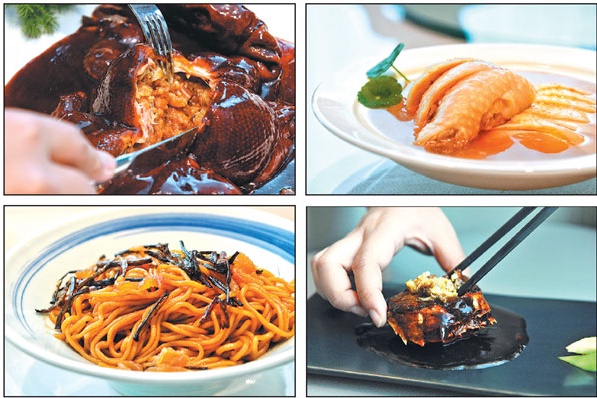
A Beijing restaurant specializing in old Shanghai cuisine is reviving interest in disappearing dishes deemed too difficult to prepare. Li Yingxue reports.
Some traditional Shanghai dishes can often be difficult to find at restaurants even in Shanghai, but luckily they are enjoying something of a renaissance at one restaurant in Beijing.
"Wulixiang", a phrase in the local Shanghai dialect which means home, is exactly what founder and chef Zhu Haifeng has called his restaurant.
With more than 20 years' experience in the kitchen, the Shanghai chef started Wulixiang as a private kitchen in Xiezuo Hutong four years ago, to bring a taste of the lanes and alleyways of authentic old Shanghai to Beijing.
With only one waitress to help with serving, Zhu took care of the entire cooking process, from shopping at markets to developing the menus. His meticulous selection of ingredients and precise cooking skills soon garnered him many fans.
"I was happy to be busy cooking all day, but then I realized that my dream of reviving Shanghai cuisine would hardly come true if I continued running a small kitchen," Zhu says.
In August this year, Wulixiang restaurant opened on the ground floor of Pacific Century Place, in the center of Sanlitun. The new restaurant, with a 40-seat dining room, is equipped with three private dining rooms, along with a dedicated bar and wine cellar.
"In the face of so much creativity and innovation in today's restaurant scene, many old dishes are being forgotten," says the 45-year-old.
"I want to make sure that these dishes are passed down to the next generation, no matter how intricate the cooking methods are, or how specific the ingredients."
Now with a cooking team handpicked by Zhu, he has more time to focus on researching and experimenting with old Shanghai dishes.
Stuffed river snails is a traditional delicacy at Wulixiang, but it's getting hard to find even in Shanghai because the dish is so time-consuming to prepare.
It's a complex dish where the snail meat is removed from the shell, diced, and mixed with minced pork leg and seasonings, before being returned to the shell and then gently steamed.
Eight treasures stuffed duck is another traditional dish that used to appear on Shanghai dinner tables. Wulixiang's version uses the most traditional Shanghai-style cooking method - a whole deboned duck stuffed with a mixture of eight high-quality ingredients, including sticky rice, lotus seeds, ham, chicken, dried scallops, dried shiitake mushrooms, and bamboo shoots - is first roasted before it's steamed.
The complicated boning, stuffing and steaming process can take three to four hours, but the gamy scent of the roasted duck and the rich, savory smells of the stuffing ingredients make it worth the wait.
The duck dish has to be pre-ordered because it takes so much time to prepare, as do many other dishes like deboned pig trotters, steamed crab scented with rice wine, and fish head soup in a clay pot.
Some dishes on the regular menu also show Zhu's skill and love for home-cooked Shanghai cuisine.
Sizzling eel is always the signature dish of dinner at Wulixiang, as the oil sizzles with fragrance as it is poured onto the freshly cooked strips of wild-caught eel. It is rich but not oily, as the oil merely coats the eel.
Hairy crab, which Zhu gets from Taihu Lake in Jiangsu province, can be cooked in a variety of ways in the chef's hands, but steaming is the best way to preserve its natural flavor. But flour-coated or stuffed-and-fried crab dishes both have rich flavors, Zhu says.
Soup with shredded chicken, ham and bamboo is a test of any chef 's knife skills, as each of the ingredients has to be sliced into equally-sized thin strips. Also, the light but richly flavored broth is another test of the chef's patience.
"We use hens over three years old, duck, pork leg and pork ribs and cook them together for eight hours," Zhu says. "And then we put minced chicken into the soup for another two to three hours to make the soup clear."
"I believe we could adjust the cooking methods used in traditional dishes a little, but we have to retain the original techniques. No single step can be missed out," says Zhu.
To make the dishes authentically Shanghai-flavored, Zhu purchases the ham and shrimp roes from Shanghai, and some ingredients and vegetables chosen for his Beijing menu are also transported from his hometown.
On Oct 28, Zhu organized a culinary course at Wulixiang to teach his customers how to cook two signature dishes in Shanghai cuisine - scallion oil noodles and drunken chicken.
"I want to present to our customers the culture of traditional Chinese food," he says.
Feng Yiran, 24, a Shanghai cuisine lover, joined Zhu's class. "I've tried to make scallion oil noodles at home, but I failed," Feng says. "After chef Zhu showed us how to properly boil the noodles and create the scallion oil, I think I will be able to nail it next time."
"The trick is to get the right proportion between the scallions and the oil."
Feng also tried Zhu's signature dishes. "The dishes and the environment at Wulixiang remind me of what I ate and experienced in Shanghai," Feng says.
Shanghai cuisine has not entered the mainstream in the capital's dining scene, but Zhu believes there is no need to alter the flavor to appeal to northern tastes. "Good food isn't separated by region. If you cook it the right way, everyone will enjoy it."



